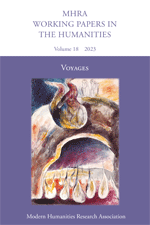‘Dicono li Ethiopi’: Ethiopian contributions to Francisco Álvares’s travel account to Ethiopia (c.1540)
Mathilde Alain
MHRA Working Papers in the Humanities (2024), pp. 5-14, doi:10.59860/wph.a27411a
Click cover to enlarge Open access licence: | A contribution to: Voyages Edited by Emily Di Dodo and Rachel Hayes MHRA Working Papers in the Humanities 18 Modern Humanities Research Association Abstract. From 1520 to 1526, the Portuguese chaplain Francisco Álvares accompanied a diplomatic embassy to Ethiopia. Following his journey, he wrote the travel account Ho Preste Joam das Indias, published in Portugal in 1540. The original manuscript, presumably in Portuguese, has been lost but five Italian manuscripts survive, several of which were composed posthumously to Álvares. These manuscripts bear differences to the Portuguese publication. The 1542 revision by the Italian humanist Ludovico Beccadelli, La historia d’Ethiopia, is particularly interesting because it includes forty-two addizioni based on exchanges with Ethiopian scholars in Rome, together with additional information disseminated across the account. These Ethiopian addizioni and contributions, mainly about religious and royal customs and geographical information, are the focus of this article. The addizioni open a window onto the presence and contributions of Ethiopian scholars to contemporary intellectual life in Renaissance Europe. They concern details about which Europeans would have been ignorant, even those who had travelled to Ethiopia like Álvares. They show that African as well as European scholars contributed to knowledge of African countries like Ethiopia in Europe — in this case by correcting Álvares’s text during the process of its reception and transmission amongst other European scholars like Beccadelli. These clarifications sought out by Beccadelli for an Italian revision of a text written in Portuguese about a journey through Ethiopia demonstrate the multiplicity of actors involved in a text’s voyage from its composition to its dissemination. Full text. This contribution is published as Open Access and can be downloaded as a PDF, or viewed as a PDF in your web browser, here: |

